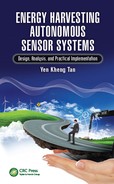Contents
1.1 Motivation of Wireless Sensor Networks (WSNs)
1.1.3 Wireless Sensor Nodes of WSNs
1.2 Problems in Powering Wireless Sensor Nodes
1.2.1 High Power Consumption of Sensor Nodes
1.2.2 Limitation of Energy Sources for Sensor Nodes
1.3 Energy Harvesting Solution for Wireless Sensor Nodes
1.3.1 Overview of Energy Harvesting
1.3.2 Energy Harvesting System
1.3.3 Review of Past Works on Energy Harvesting Systems
1.3.3.1 Solar Energy Harvesting System
1.3.3.2 Thermal Energy Harvesting System
1.3.3.3 Vibration Energy Harvesting System
1.3.3.4 Wind Energy Harvesting System
2. Wind Energy Harvesting System
2.1 Direct Wind Energy Harvesting (WEH) Approach Using a Wind Turbine Generator
2.1.2 Design of an Efficient Power Management Circuit
2.1.2.1 Active AC-DC Converter
2.1.2.2 Boost Converter with Resistor Emulation-Based Maximum Power Point Tracking (MPPT)
2.1.3.1 Performance of WEH System with an MPPT Scheme
2.1.3.2 Power Conversion Efficiency of the WEH System
2.2 Indirect WEH Approach Using Piezoelectric Material
2.2.1 Vibration-Based Piezoelectric Wind Energy Harvester
2.2.1.2 Cantilever Beam Theory
2.2.2 Characteristics and Performances of a Piezoelectric Wind Energy Harvester
3. Thermal Energy Harvesting System
3.1.1 Description of a Thermoelectric Generator
3.1.2 Analysis of the Thermal Energy Harvester
3.1.3 Characterisation of a Thermal Energy Harvester
3.2 Resistor Emulation-Based Maximum Power Point Tracker
3.3 Implementation of an Optimal Thermal Energy Harvesting Wireless Sensor Node
3.3.1 Buck Converter with Resistor Emulation-Based Maximum Power Point Tracking
3.3.3 Regulating a Buck Converter and Wireless Sensor Node
4. Vibration Energy Harvesting System
4.1 Impact-Based Vibration Energy Harvesting (VEH) Using a Piezoelectric Push-Button Igniter
4.1.1 Piezoelectric Push Button
4.1.2 Energy Storage and the Power Processing Unit
4.2 Impact-Based VEH Using Prestressed Piezoelectric Diaphragm Material
4.2.1 Description of Prestressed Piezoelectric Diaphragm Material
4.2.2 Characteristics and Performance of THUNDER Lead-Zirconate-Titanate Unimorph
4.2.3 Power Management Circuit
5. Hybrid Energy Harvesting System
5.1 Solar Energy Harvesting (SEH) System
5.2 Composite Solar, Wind (S+W) Energy Sources
5.2.1 Wind Energy Harvesting Subsystem
5.2.2.1 Characterisation of a Solar Panel
5.2.2.2 Boost Converter with Constant-Volage-Based Maximum Power Point Tracking (MPPT)
5.2.2.3 Performance of SEH Subsystem
5.2.3 Hybrid Solar and Wind Energy Harvesting System
5.2.4.1 Performance of the Hybrid Energy Harvesting (HEH) System
5.2.4.2 Power Conversion Efficiency of the HEH System
5.3 Composite Solar, Thermal (S+T) Energy Sources
5.3.1 Overview of Indoor Energy Sources
5.3.3 Thermal Energy Harvesting Subsystem
5.3.4 HEH from Solar and Thermal Energy Sources
5.3.4.1 Characteristics of a Solar Panel and Thermal Energy Harvester Connected in Parallel
5.3.4.2 Design and Implementation of an Ultralow-Power Management Circuit
5.3.5.1 Performance of a Parallel HEH Configuration
5.3.5.2 Power Conversion Efficiency of the HEH System
5.3.5.3 Performance of the Designed HEH System for an Indoor Wireless Sensor Node
6. Electrical Power Transfer with “No Wires”
6.1 Inductively Coupled Power Transfer from Power Lines
6.1.1 Magnetic Energy Harvester
6.1.1.1 Performance of the Magnetic Energy Harvester
6.1.2 Power Management Circuit
6.2 Wireless Power Transfer (WPT) via Strongly Coupled Magnetic Resonances
6.2.1 Concept Principles of WPT with Magnetic Resonance
6.2.2.1 Simulation of Efficiency versus Frequency
6.2.2.2 Simulation of Efficiency versus Coil Radius
6.2.2.3 Simulation of Efficiency versus Number of Turns
6.2.2.4 Simulation of Efficiency versus Distance
6.2.3 Characteristics of the WPT System
6.2.3.1 Experimental Efficiency versus Frequency
6.2.3.2 Experimental Efficiency versus Distance
6.2.3.3 Experimental Efficiency versus Load
6.2.4.1 WPT System Powering Electrical Load(s)
6.2.4.2 Network of WPT Resonator Coils
